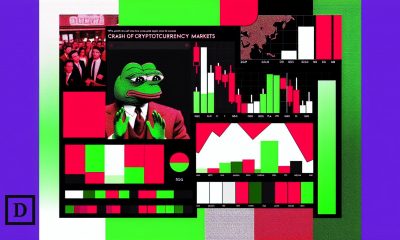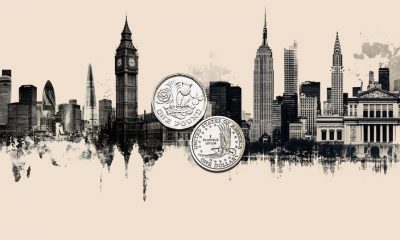

others
Gold hits weekly high amid softer risk tone, modest USD strength to cap gains – Crypto News
- Gold price gains traction for the second straight day and refreshes weekly top on Wednesday.
- A softer risk tone and dovish Fed expectations continue to act as a tailwind for the XAU/USD.
- The USD climbs to a nearly two-week high and might cap gains ahead of global PMI releases.
Gold price (XAU/USD) builds on the overnight recovery from the vicinity of over a one-week low and attracts follow-through buyers for the second successive day on Wednesday. The uptick is sponsored by a weaker risk tone, which tends to benefit traditional safe-haven assets, and lifts the precious metal to a fresh weekly top, around the $2,415 region during the Asian session. Apart from this, bets that the Federal Reserve (Fed) will start cutting interest rates in September further contribute to driving flows towards the non-yielding yellow metal.
Meanwhile, the US Dollar (USD) has climbed to a nearly two-week low amid an uptick in the US Treasury bond yields and is likely to keep a lid on any further appreciating move for the gold price. Traders might also prefer to wait for more cues about the Fed’s policy path before placing fresh directional bets around the non-yielding yellow metal. Hence, the market focus will remain glued to the release of the Advance US Q2 GDP and the US Personal Consumption Expenditures (PCE) Price Index data on Thursday and Friday, respectively.
Daily Digest Market Movers: Gold price benefits from September rate cut bets and a softer risk tone
- A modest slide in the US Treasury bond yields, along with a softer risk tone, assisted the Gold price to gain positive traction on Tuesday and move away from over a one-week low touched the previous day.
- The National Association of Realtors reported that US existing home sales fell 5.4% in June to a seasonally adjusted annual rate of 3.89 million units – the lowest since December and missing consensus estimates.
- The most recent survey from the Federal Reserve Bank of Richmond showed that manufacturing activity worsened in July and the composite manufacturing index fell to -17 in July from -10 in the previous month.
- US Vice President Kamala Harris secured the support of enough delegates to clinch the Democratic nomination, which prompted some unwinding of the ‘Trump trade’ and dragged the US bond yield lower.
- Investors, meanwhile, largely expect the US central bank to start lowering borrowing costs at its September meeting and have been pricing in the possibility of two more rate cuts by the end of this year.
- This, in turn, offers some support to the non-yielding yellow metal, though some follow-through US Dollar buying keeps a lid on any further appreciating move as traders await the key US macroeconomic data.
- The US Gross Domestic Product (GDP) report for the second quarter will be released on Thursday and will be followed by the crucial Personal Consumption Expenditures (PCE) Price Index data for June on Friday.
- This will provide fresh insight into the Fed’s path for interest rates, which will play a key role in influencing the USD price dynamics and help in determining the next leg of a directional move for the XAU/USD.
- In the meantime, Wednesday’s release of flash PMIs will be looked upon for cues about the health of the global economy and allow traders to grab short-term opportunities around the precious metal.
Technical Analysis: Gold price could accelerate positive move once the $2,417-2,418 hurdle is cleared
From a technical perspective, this week’s bounce from the $2,385 resistance breakpoint – now coinciding with the 100-period Simple Moving Average (SMA) on the 4-hour chart and the 50% retracement level of the June-July rally – warrants caution for bearish traders. The said area should now act as a key pivotal point, which if broken decisively should pave the way for deeper losses. The Gold price might then slide to 61.8% Fibo. level, around the $2,366-2,365 region, en route to the $2,352-2,350 zone before eventually dropping to 78.6% Fibo. level, near the $2,334-2,334 area, and the $2,300 mark.
On the flip side, any subsequent move up is likely to confront some resistance near the $2,417-2,418 zone, above which a fresh bout of a short-covering move could lift the Gold price to the $2,437-2,438 region. Some follow-through buying beyond the latter will suggest that the recent downfall witnessed over the past week or so has run its course and shift the near-term bias back in favor of bullish traders. The momentum could then extend back towards retesting the all-time peak, around the $2,482 area touched on July 17, with some intermediate resistance near the $2,458 region.
Risk sentiment FAQs
In the world of financial jargon the two widely used terms “risk-on” and “risk off” refer to the level of risk that investors are willing to stomach during the period referenced. In a “risk-on” market, investors are optimistic about the future and more willing to buy risky assets. In a “risk-off” market investors start to ‘play it safe’ because they are worried about the future, and therefore buy less risky assets that are more certain of bringing a return, even if it is relatively modest.
Typically, during periods of “risk-on”, stock markets will rise, most commodities – except Gold – will also gain in value, since they benefit from a positive growth outlook. The currencies of nations that are heavy commodity exporters strengthen because of increased demand, and Cryptocurrencies rise. In a “risk-off” market, Bonds go up – especially major government Bonds – Gold shines, and safe-haven currencies such as the Japanese Yen, Swiss Franc and US Dollar all benefit.
The Australian Dollar (AUD), the Canadian Dollar (CAD), the New Zealand Dollar (NZD) and minor FX like the Ruble (RUB) and the South African Rand (ZAR), all tend to rise in markets that are “risk-on”. This is because the economies of these currencies are heavily reliant on commodity exports for growth, and commodities tend to rise in price during risk-on periods. This is because investors foresee greater demand for raw materials in the future due to heightened economic activity.
The major currencies that tend to rise during periods of “risk-off” are the US Dollar (USD), the Japanese Yen (JPY) and the Swiss Franc (CHF). The US Dollar, because it is the world’s reserve currency, and because in times of crisis investors buy US government debt, which is seen as safe because the largest economy in the world is unlikely to default. The Yen, from increased demand for Japanese government bonds, because a high proportion are held by domestic investors who are unlikely to dump them – even in a crisis. The Swiss Franc, because strict Swiss banking laws offer investors enhanced capital protection.
-

 Metaverse1 week ago
Metaverse1 week agoWhat Satya Nadella’s latest shakeup says about Microsoft’s evolving AI strategy – Crypto News
-

 Metaverse1 week ago
Metaverse1 week agoWhat Satya Nadella’s latest shakeup says about Microsoft’s evolving AI strategy – Crypto News
-

 Technology1 week ago
Technology1 week agoAI isn’t the dot-com bubble, but that won’t stop it from ending badly – Crypto News
-

 Technology1 week ago
Technology1 week agoChatGPT will soon pay for you! India’s AI payment pilot set to go live: What it means for users – Crypto News
-

 Technology7 days ago
Technology7 days agoBest phones under ₹15,000: Oppo K13 5G, Infinix Note 50s, iQOO Z10x and more – Crypto News
-

 others7 days ago
others7 days agoChina’s Commerce Ministry urges US to correct its wrong practices as soon as possible – Crypto News
-

 others1 week ago
others1 week agoEUR/JPY retreats as Euro slides on French political uncertainty – Crypto News
-

 Metaverse1 week ago
Metaverse1 week agohuman intelligence for artificial minds – Crypto News
-

 Cryptocurrency5 days ago
Cryptocurrency5 days agoStripe’s stablecoin biz seeks national bank trust charter – Crypto News
-
Business1 week ago
ASTER Airdrop Delayed to October 20 Amid Criticisms Over Token Allocations – Crypto News
-
Technology1 week ago
STON.fi CMO on Building TON’s Largest Swap & Liquidity Aggregator – Crypto News
-
Technology1 week ago
Tom Lee’s Fundstrat Predicts Ethereum Rally to $5,500 Following ETH ‘Bottom’ – Crypto News
-

 Cryptocurrency1 week ago
Cryptocurrency1 week agoThe Latest Nobel Peace Prize Winner Is a Bitcoin Supporter – Crypto News
-

 others1 week ago
others1 week agoA balanced approach to monetary policy only works if inflation expectations are anchored – Crypto News
-

 Metaverse5 days ago
Metaverse5 days agoWalmart teams with OpenAI for ChatGPT purchases. The retailer is ‘ahead of the curve’. – Crypto News
-
Business1 week ago
Bank of America, Citigroup and Goldman Sachs Explore Issuing Stablecoins Pegged to G7 Currencies – Crypto News
-

 De-fi1 week ago
De-fi1 week agoLarva Labs Art Blocks Auction Surpasses $30,000 – Crypto News
-

 Technology1 week ago
Technology1 week agoBose Angers Customers by Ending Cloud Streaming for Old Speakers – Crypto News
-

 Technology1 week ago
Technology1 week agoBose Angers Customers by Ending Cloud Streaming for Old Speakers – Crypto News
-

 Cryptocurrency1 week ago
Cryptocurrency1 week agoCrypto liquidations drive historic market turbulence – Crypto News
-
others1 week ago
Peter Brandt Flips Bullish on Bitcoin, Ethereum, XRP, and XLM – Crypto News
-

 Blockchain1 week ago
Blockchain1 week agoHow to Use ChatGPT to Discover Hidden Crypto Gems – Crypto News
-

 Cryptocurrency1 week ago
Cryptocurrency1 week agoWhy Bitcoin could rebound up to 21% this week: experts explain – Crypto News
-
others1 week ago
U.S. Inflation Data: BLS to Release CPI Report on October 24 Amid Government Shutdown – Crypto News
-

 Cryptocurrency1 week ago
Cryptocurrency1 week agoOutages hit Binance, Coinbase, and Robinhood as $9.5 billion liquidations hit the market – Crypto News
-
Business1 week ago
Crypto Market Loses $670 Billion on CEX Auto Liquidations, Altcoins Crash Intensifies – Crypto News
-

 Metaverse1 week ago
Metaverse1 week agoIndia key to shaping future of Artificial Intelligence, says Anthropic CEO Dario Amodei after meeting PM Modi – Crypto News
-

 Blockchain1 week ago
Blockchain1 week agoCrypto Traders Show ‘Rationalization’ Behavior’ After Market Plunge – Crypto News
-

 others1 week ago
others1 week agoTrump’s tariff threat pushes US Dollar below 99 amid trade tensions – Crypto News
-

 Cryptocurrency1 week ago
Cryptocurrency1 week agoHow Solana Overtook Ethereum’s Early Growth Curve – Crypto News
-
Technology1 week ago
Breaking: China Renaissance Bank Eyes $600M Raise for BNB-Focused Fund with YZI Labs – Crypto News
-

 De-fi1 week ago
De-fi1 week agoDeFi Withstands Stress Test as Market Mayhem Wipes Out Nearly $20B – Crypto News
-
Technology6 days ago
XRP Price Crashes as Whales Dump 2.23B Tokens — Is $2 the Next Stop? – Crypto News
-

 Cryptocurrency6 days ago
Cryptocurrency6 days agoPowell speech steadies crypto market: Fed hints at slower balance-sheet runoff – Crypto News
-

 others6 days ago
others6 days agoSeems ‘prudent’ to cut rates further given lower inflation risks – Crypto News
-
Business6 days ago
Pro Says Ethereum Price is a Buy Despite Rising Liquidations and BlackRock Selling – Crypto News
-
Business6 days ago
Pro Says Ethereum Price is a Buy Despite Rising Liquidations and BlackRock Selling – Crypto News
-

 Technology1 week ago
Technology1 week agoPENGU turns bullish as Pudgy Penguins teams up with Nasdaq-listed Sharps Technology – Crypto News
-

 Cryptocurrency1 week ago
Cryptocurrency1 week agoPolymarket Token Is Coming, But Likely Not This Year: Sources – Crypto News
-

 De-fi1 week ago
De-fi1 week agoCrypto Markets Plummet as BTC Briefly Drops Below $106K – Crypto News
-
Business1 week ago
Here’s Why XRP Price May Have a Zcash-Like Surge – Crypto News
-

 Cryptocurrency1 week ago
Cryptocurrency1 week agoCrypto Market Prediction: Shiba Inu’s (SHIB) Last Chance at $0.000012? XRP Skyrocketing Hidden, Ethereum (ETH) for $5,000 Should Be Forgotten – Crypto News
-

 Metaverse1 week ago
Metaverse1 week agoClaude automates reports and presentations effortlessly – Crypto News
-

 Technology1 week ago
Technology1 week agoAmazon Diwali bonanza: Top 5 deals on flagship mobiles you should not miss – iPhone 16, OnePlus 13 & more – Crypto News
-
Business1 week ago
Is the Bitcoin Top In? Raoul Pal Signals Higher Liquidity Cycle Despite Market Selloff – Crypto News
-

 Cryptocurrency1 week ago
Cryptocurrency1 week agoShiba Inu Burn Rate Crashes 99% as Crypto Sees Largest Liquidation Event Ever – Crypto News
-

 Cryptocurrency1 week ago
Cryptocurrency1 week agoDecoding WLFI’s meltdown – Can a $7mln buyback undo a $190mln dump? – Crypto News
-
others1 week ago
Binance Founder CZ Addresses BNB’s Recent Strong Price Performance, Says It Has No Market Makers – Crypto News
-

 others1 week ago
others1 week agoWhich way out of the range – Crypto News
-
Business1 week ago
Crypto Market Recovery: BTC, ETH, XRP, DOGE Surge 4-12% As Expert Sees V-Shape Upside – Crypto News










